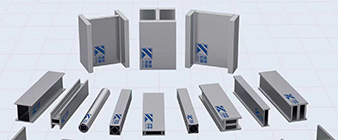S960 steel is known for its high yield strength and excellent toughness and is increasingly used in various structural applications, especially heavy construction. The following are the key aspects of S960 steel structure fabrication:
Material Properties
High strength: S960 steel has a minimum yield strength of 960 MPa, allowing for lighter structures and reduced material use.
Toughness: Maintains good toughness at low temperatures, making it suitable for various environmental conditions.
Manufacturing Process
Cutting: Common methods include oxygen fuel cutting, plasma cutting, laser cutting, etc. Precision cutting ensures accurate dimensions and reduces waste.
Bending: When using a bending machine or curling machine, the high strength of the material should be considered to avoid cracking. Proper tools are crucial.
Welding: Follow specific welding procedures to prevent problems like cracks. Preheating may be required and suitable filling material should be selected.
Welding Precautions
Preheat: Preheating to 100-150°C helps reduce the risk of cold cracking, especially in thicker sections.
Filler material: Use low-alloy filler material that is compatible with S960 steel to ensure mechanical properties are maintained.
Post-Weld Treatment: Post-weld heat treatment (PWHT) may be required to relieve stress and improve toughness.
Assembly technology
Joints and Connections: Use bolted or welded connections designed to handle high loads. Make sure the connectors are properly aligned and secure.
Temporary Supports: During assembly, temporary supports may be required to maintain stability until the structure is fully erected.
Quality Control
Non-destructive testing (NDT): Non-destructive testing methods such as ultrasonic testing or radiographic testing are performed to ensure weld integrity and detect any defects.
Inspection: Regular inspections during the manufacturing process to ensure compliance with design specifications and standards.
Surface treatment
Corrosion Protection: Applying a protective coating, such as galvanizing or painting, to enhance corrosion resistance, especially to structures exposed to harsh environments.
Surface Preparation: Before applying a coating, proper surface preparation is critical to ensure adhesion and durability.
Transportation and Installation
Precautions for handling: Due to its high strength and heavy weight, care must be taken during transportation to avoid damage.
Installation Techniques: Use cranes and rigging equipment designed for heavy loads and ensure safety protocols are followed during installation.
Sustainability considerations Material efficiency: High strength reduces the use of materials, thereby lowering the carbon footprint in construction.
The fabrication of S960 steel structures requires careful planning and execution to take full advantage of its high strength and toughness. By following best practices in cutting, welding, assembly and quality control, manufacturers can ensure the integrity and performance of the final structure.
- Previous:S690 steel Welding
- Next:Application of S960 steel in buildings
-
 2024-9-29 Alloy 602 CA / 2.4633/N06025 Nickel-based alloy hollow structural profiles
2024-9-29 Alloy 602 CA / 2.4633/N06025 Nickel-based alloy hollow structural profiles -
 2024-9-21 What other applications of S960 steel are commonly found in building construction?
2024-9-21 What other applications of S960 steel are commonly found in building construction? -
 2024-9-15 Introduction to the performance of 1.4301/1.4307 stainless steel
2024-9-15 Introduction to the performance of 1.4301/1.4307 stainless steel -
 2024-2-20 310 (1.4845) stainless steel plate
2024-2-20 310 (1.4845) stainless steel plate -
 2024-9-29 Alloy 2.4663 (N06617) Structural Hollow Profiles
2024-9-29 Alloy 2.4663 (N06617) Structural Hollow Profiles -
 2024-9-24 310S stainless steel structural Beams and columns
2024-9-24 310S stainless steel structural Beams and columns -
 2024-9-25 318LN / 1.4462 Duplex Stainless Steel Structural Profiles
2024-9-25 318LN / 1.4462 Duplex Stainless Steel Structural Profiles



